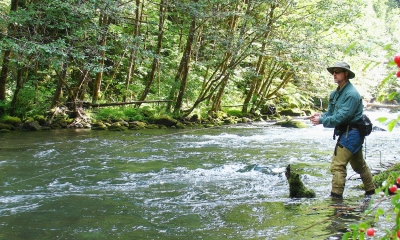
How to recognize and report poaching on the water
Each year, thousands of fish are harvested illegally in Oregon. Anglers who wait all year for their favorite salmon or steelhead run shouldn’t face reduced opportunity because of poaching.
To report poaching call *OSP or 1-800-452-7888

Poaching is defined as taking/killing a fish or animal illegally, and can take many forms. Fishing without a license or tag, exceeding the bag limit, fishing out of season, fishing for salmon or trout at night, snagging fish, harvesting someone else’s limit – all are examples of poaching.
In 2019, the Oregon Legislature passed legislation directing the Oregon Department of Fish and Wildlife, Oregon State Police and Department of Justice to work together on a plan to improve the reporting, enforcement and prosecution of poaching activities. Learn more about this new campaign.
Here’s where you come in. ODFW biologists and OSP troopers can’t be everywhere. They depend on hunters, anglers and other wildland users to report poaching and other suspicious behavior they see in the field.
How to identify poachers on the water
Snagging is keeping a fish that has been hooked somewhere besides in the mouth. Here are a couple of ways to identify it:
- If you see someone fishing and they begin to aggressively yank on the line several times to try to hook a fish. Not to be confused with setting the hook, which is usually one or two sharp tugs.
- If someone lands and keeps a fish that has been hooked in the back or tail, instead of in the mouth.
Chumming is throwing bait, not attached to a hook, into the water to attract fish. It’s usually done from a boat and is illegal. You may notice someone dumping a bucket of something over the side of the boat and/or a greasy “slick” on the surface of the water caused by dead fish and other stinky, chum stuff.
Wasting fish happens when an angler catches and then discards a fish. If you find dead, discarded fish on the bank without any evidence of it having been filleted or otherwise butchered, it’s been wasted.
Using live fish for bait, which is illegal except in tidewater. The accidental introduction of bait species into Oregon waters has cost the state millions of dollars. These fish can sometimes reproduce rapidly and flourish at the expense of other, more popular species like trout*. Most times, excess bait fish get dumped in the water at the end of a day’s fishing.
You may see anglers dumping a bucket of what looks like water and small fish over the side of a boat, or anglers tending to a live well (with live bait fish?) before they launch.
*What happened at Diamond Lake in the early 2000s is a good example of the impact illegally dumped live bait fish can have on a fishery. Read more about it here.
Catching someone else’s limit. This often occurs when a skilled crabber, clammer or angler quickly catches their own limit and begins to hand off additional crabs, clams or fish to other less successful members of their party.
People often will try to disguise this by sharing a stringer, crab pot or clam bag with someone else.
Exceeding the bag limit. People can be sneaky when it comes to disguising how many fish, crabs or clams they have.
You may see an angler leave with a limit if fish, only to return later (maybe even wearing different clothes) to fish again. Anglers may also try to hide fish in their car, an ice chest or even in nearby brush so they can continue fishing illegally.
Using two rods to fish for salmon and steelhead. Anglers who purchase a Two-Rod Validation can use two rods to fish for trout and warmwater species in standing waters*. It is not currently legal in rivers, bays or the ocean for salmon or steelhead.
If you see a single angler in a boat, trolling for salmon using two rods, it may be a violation.
*Anglers with a two rod validation may fish with up to five rods when ice fishing.
Not following size limits. This can include harvesting oversize sturgeon or undersize lingcod.
Fishing outside legal fishing hours (one hour before sunrise until one hour after sunset). This can be tricky to recognize because this rule applies only to salmon, shad, steelhead, sturgeon, trout and whitefish. For other species like bass and walleye, it’s legal to fish at night.
What to do if you see possible poaching
If you suspect poaching, the best thing to do is be a good witness. Do not confront suspected poachers! Instead, take a photo of the vehicle’s license plate; note what they are wearing; document identifying boat names or numbers; take cell phone video if it is safe to do so
Call the OSP TIP Line – dial *OSP or 1-800-452-7888 to report suspicious behavior that might be linked to poaching.
The Turn In Poachers Line (TIP Line) directs calls to OSP Fish and Wildlife Troopers who patrol the area. If someone who poaches fish and game animals is convicted, the person who reported them can receive either a cash reward or hunting preference points.
Yvonne Shaw is the ODFW anti-poaching campaign coordinator




